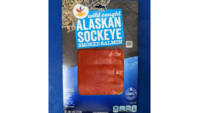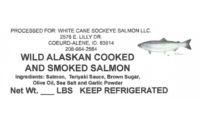From Bristol Bay to Kodiak and Prince William Sound to Southeast, 98% of the United States' wild salmon comes from Alaska waters. To honor this fish, the state is recognizing the annual Alaska Wild Salmon Day and celebrating the fishermen, industry and fish that are crucial to Alaskans and seafood fans worldwide. Alaska is home to five wild species of salmon: king, coho, sockeye, keta and pink, all of which are sustainably harvested to the highest global standards. Alaska Wild Salmon Day is a reminder of the importance to #AskForAlaska or look for “Alaska” on packaging and signage whenever choosing salmon to guarantee it is wild and sustainable.
“Alaska Wild Salmon Day recognizes not only our iconic salmon, but also the importance of origin and sustainability,” said Alaska Seafood Marketing Institute Executive Director Jeremy Woodrow. “Like all Alaska seafood, our salmon is harvested in compliance with rigorous management measures that ensure the sustainability of both the fishery and the entire surrounding marine ecosystem. Because of this dedication to sustainable management, all seafood lovers can confidently choose Alaska wild salmon knowing that it comes from the best managed fisheries in the world.”
For the 2023 salmon season currently underway, the Alaska Department of Fish & Game forecast predicts a harvest of nearly 190 million salmon. This represents an increase of 14%, by weight, from 2022. As a product of their wild environment, Alaska salmon stocks vary year to year, but the continued strength of the return is a testament to the commitment that all Alaskans, including biologists, scientists, fishermen, processors, and nongovernmental organizations, have to sustainability and responsible fisheries management.
“As fisheries managers, our highest priority is to provide for the long-term sustainability of Alaska’s wild salmon populations. We closely monitor stocks and fisheries across the State to gather real-time scientific data to determine how much harvest can occur while maintaining healthy salmon runs,” said Dani Evenson, policy advisor, Alaska Department of Fish and Game.
For example, the recent troll king salmon fishery in Southeast Alaska had an allowable catch of approximately 77,000 fish to ensure a sustainable harvest. As soon as that catch was met by fishermen, the fishery was closed. This is just one example of how fishery managers and fishermen work together to fish responsibly.
Alaska Wild Salmon Day celebrates the fishermen and industry that are proud to be on the frontlines upholding Alaska’s strict and responsible fisheries management practices.
“Fishermen like me are responsible stewards of wild seafood – we care about the quality of the seafood we harvest and about the health of the ocean. Sustainability to us means sustaining our fish populations while sustaining our livelihoods for future generations. When you choose seafood from Alaska, you not only enjoy wild, sustainable, and delicious fish, but you support American fishing families and communities that are committed to the long-term vitality of the resource,” said Matt Allard, president, United Fishermen of Alaska.
Aug. 10 was officially declared Alaska Wild Salmon Day in 2016 when Alaska Governor Bill Walker signed HB 128 into law. For more information about Alaska salmon and sustainable Alaska seafood, visit www.AlaskaSeafood.org or follow @AlaskaSeafood on Instagram and Facebook.




Report Abusive Comment